ACC00716 Finance: Capital Budgeting Analysis of Shrieves Casting
VerifiedAdded on 2022/11/26
|8
|1470
|85
Homework Assignment
AI Summary
This assignment focuses on the financial analysis of Shrieves Casting Company, examining the addition of a new product line. The analysis involves sensitivity analysis on key variables such as cost of capital, unit sales, and net working capital to assess the project's viability under different scenarios. The student calculates Net Present Value (NPV) under base-case, worst-case, and best-case scenarios, considering variations in unit sales and unit price. The assignment includes a sensitivity diagram and discusses the impact of changing variables on the project's profitability. Finally, the student makes a recommendation on whether to accept the new product line based on the financial analysis and risk assessment.
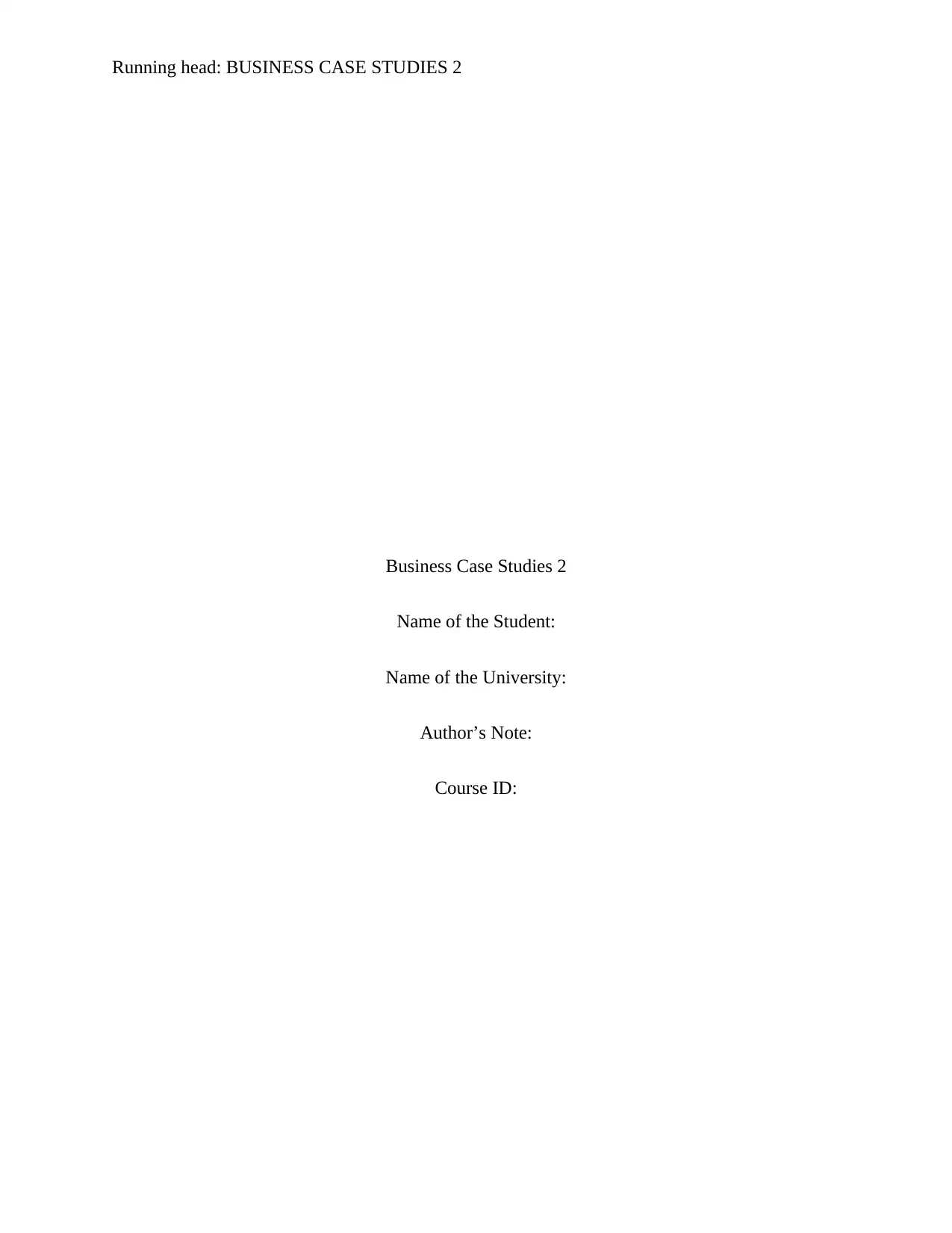
Running head: BUSINESS CASE STUDIES 2
Business Case Studies 2
Name of the Student:
Name of the University:
Author’s Note:
Course ID:
Business Case Studies 2
Name of the Student:
Name of the University:
Author’s Note:
Course ID:
Paraphrase This Document
Need a fresh take? Get an instant paraphrase of this document with our AI Paraphraser
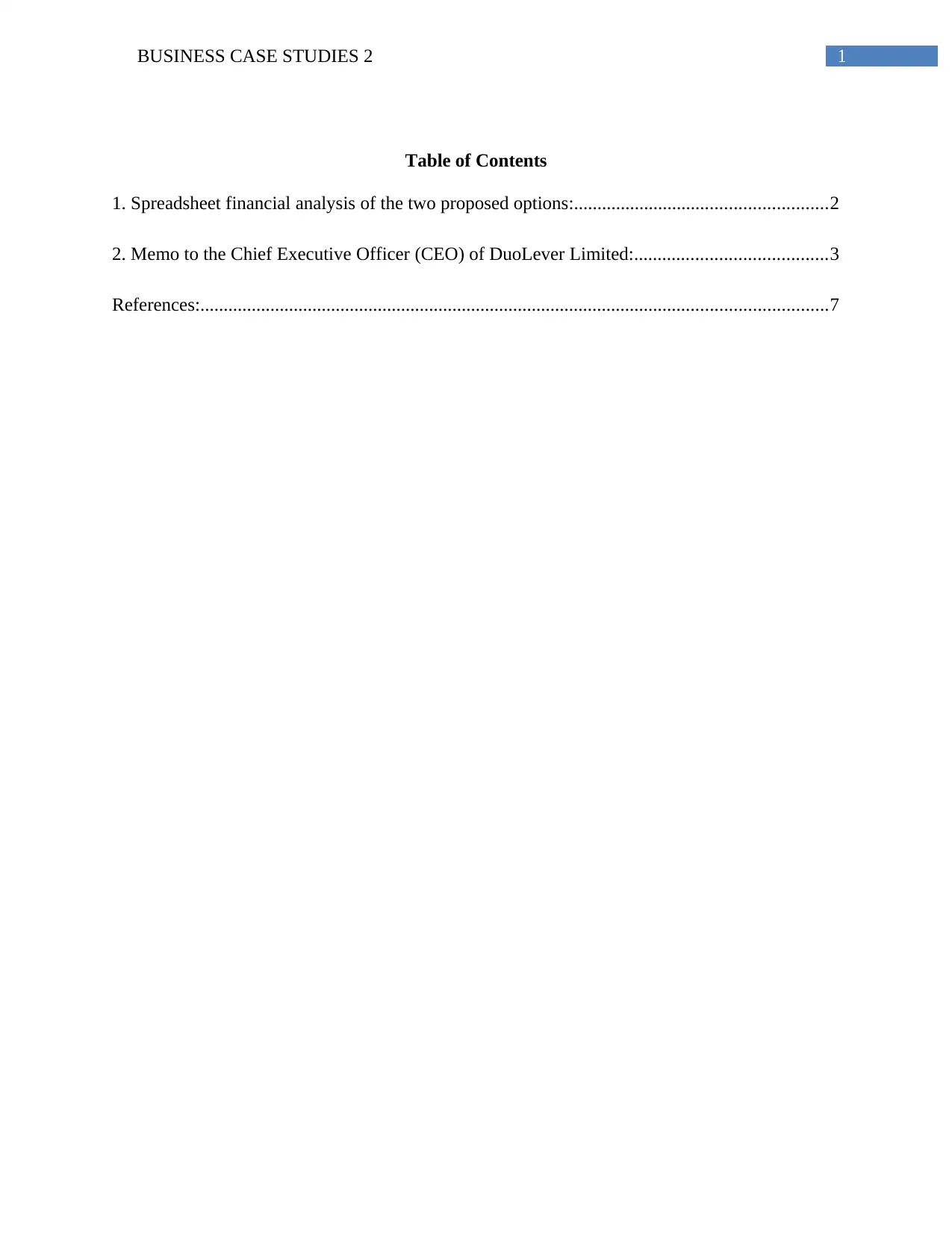
1BUSINESS CASE STUDIES 2
Table of Contents
1. Spreadsheet financial analysis of the two proposed options:......................................................2
2. Memo to the Chief Executive Officer (CEO) of DuoLever Limited:.........................................3
References:......................................................................................................................................7
Table of Contents
1. Spreadsheet financial analysis of the two proposed options:......................................................2
2. Memo to the Chief Executive Officer (CEO) of DuoLever Limited:.........................................3
References:......................................................................................................................................7
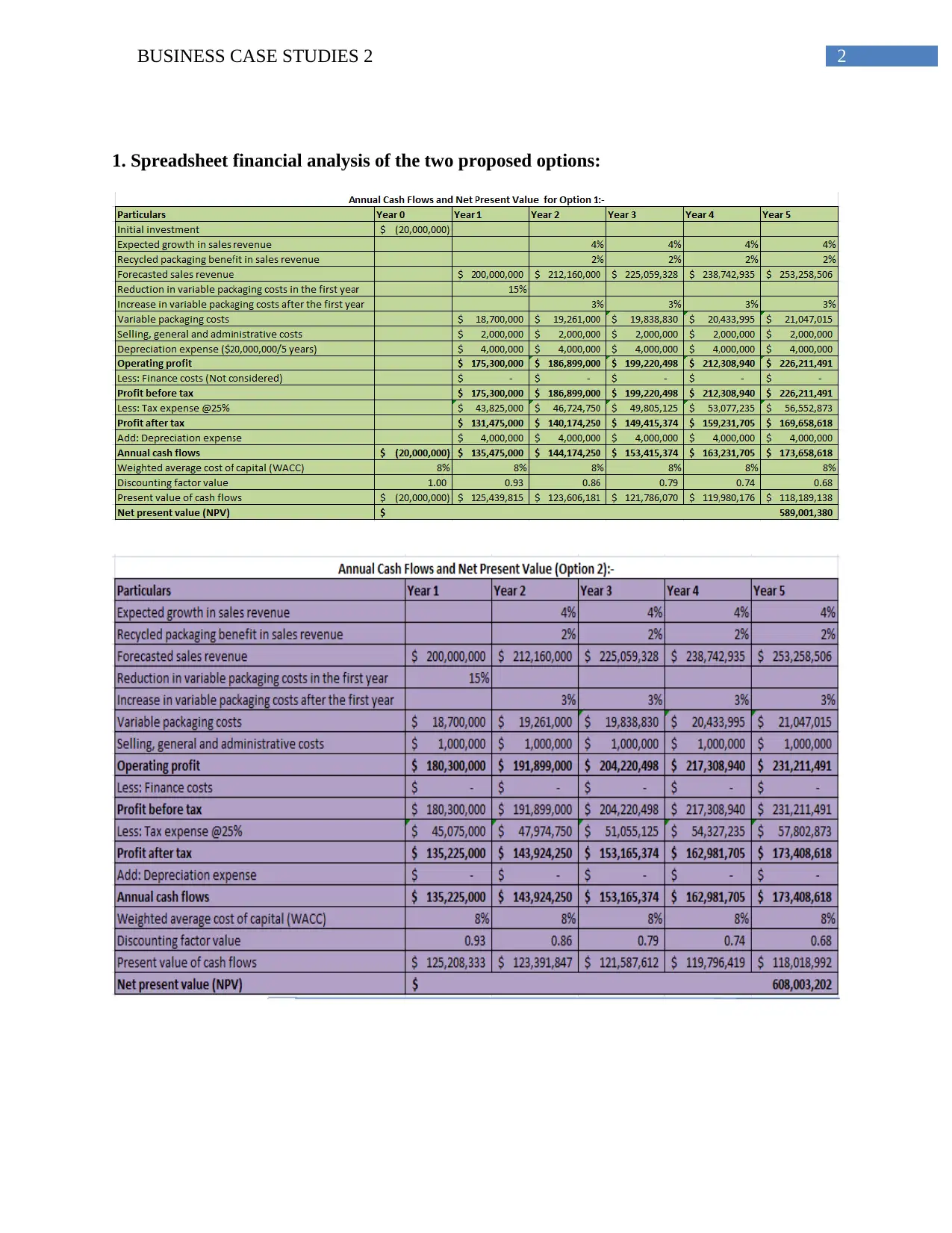
2BUSINESS CASE STUDIES 2
1. Spreadsheet financial analysis of the two proposed options:
1. Spreadsheet financial analysis of the two proposed options:
⊘ This is a preview!⊘
Do you want full access?
Subscribe today to unlock all pages.

Trusted by 1+ million students worldwide
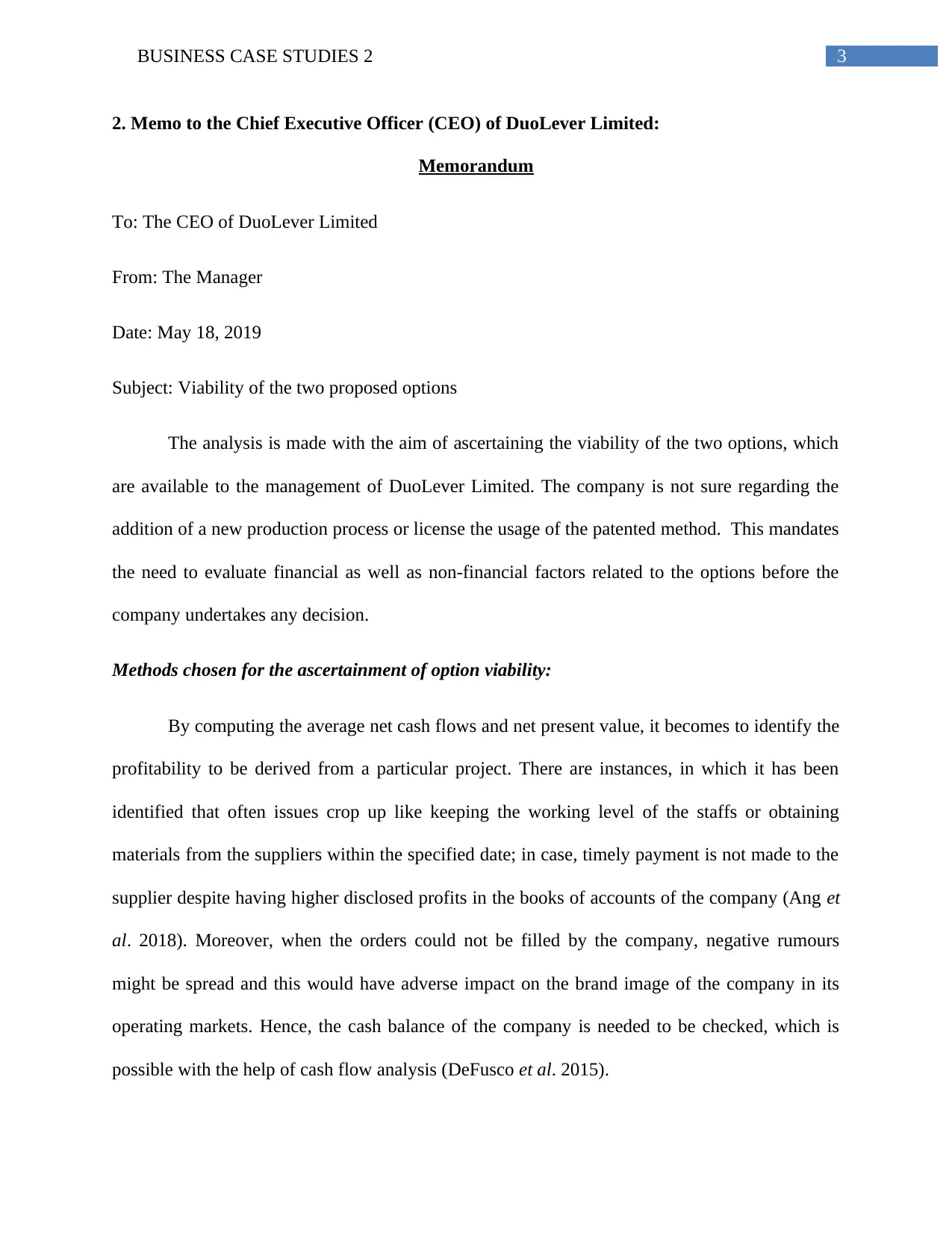
3BUSINESS CASE STUDIES 2
2. Memo to the Chief Executive Officer (CEO) of DuoLever Limited:
Memorandum
To: The CEO of DuoLever Limited
From: The Manager
Date: May 18, 2019
Subject: Viability of the two proposed options
The analysis is made with the aim of ascertaining the viability of the two options, which
are available to the management of DuoLever Limited. The company is not sure regarding the
addition of a new production process or license the usage of the patented method. This mandates
the need to evaluate financial as well as non-financial factors related to the options before the
company undertakes any decision.
Methods chosen for the ascertainment of option viability:
By computing the average net cash flows and net present value, it becomes to identify the
profitability to be derived from a particular project. There are instances, in which it has been
identified that often issues crop up like keeping the working level of the staffs or obtaining
materials from the suppliers within the specified date; in case, timely payment is not made to the
supplier despite having higher disclosed profits in the books of accounts of the company (Ang et
al. 2018). Moreover, when the orders could not be filled by the company, negative rumours
might be spread and this would have adverse impact on the brand image of the company in its
operating markets. Hence, the cash balance of the company is needed to be checked, which is
possible with the help of cash flow analysis (DeFusco et al. 2015).
2. Memo to the Chief Executive Officer (CEO) of DuoLever Limited:
Memorandum
To: The CEO of DuoLever Limited
From: The Manager
Date: May 18, 2019
Subject: Viability of the two proposed options
The analysis is made with the aim of ascertaining the viability of the two options, which
are available to the management of DuoLever Limited. The company is not sure regarding the
addition of a new production process or license the usage of the patented method. This mandates
the need to evaluate financial as well as non-financial factors related to the options before the
company undertakes any decision.
Methods chosen for the ascertainment of option viability:
By computing the average net cash flows and net present value, it becomes to identify the
profitability to be derived from a particular project. There are instances, in which it has been
identified that often issues crop up like keeping the working level of the staffs or obtaining
materials from the suppliers within the specified date; in case, timely payment is not made to the
supplier despite having higher disclosed profits in the books of accounts of the company (Ang et
al. 2018). Moreover, when the orders could not be filled by the company, negative rumours
might be spread and this would have adverse impact on the brand image of the company in its
operating markets. Hence, the cash balance of the company is needed to be checked, which is
possible with the help of cash flow analysis (DeFusco et al. 2015).
Paraphrase This Document
Need a fresh take? Get an instant paraphrase of this document with our AI Paraphraser
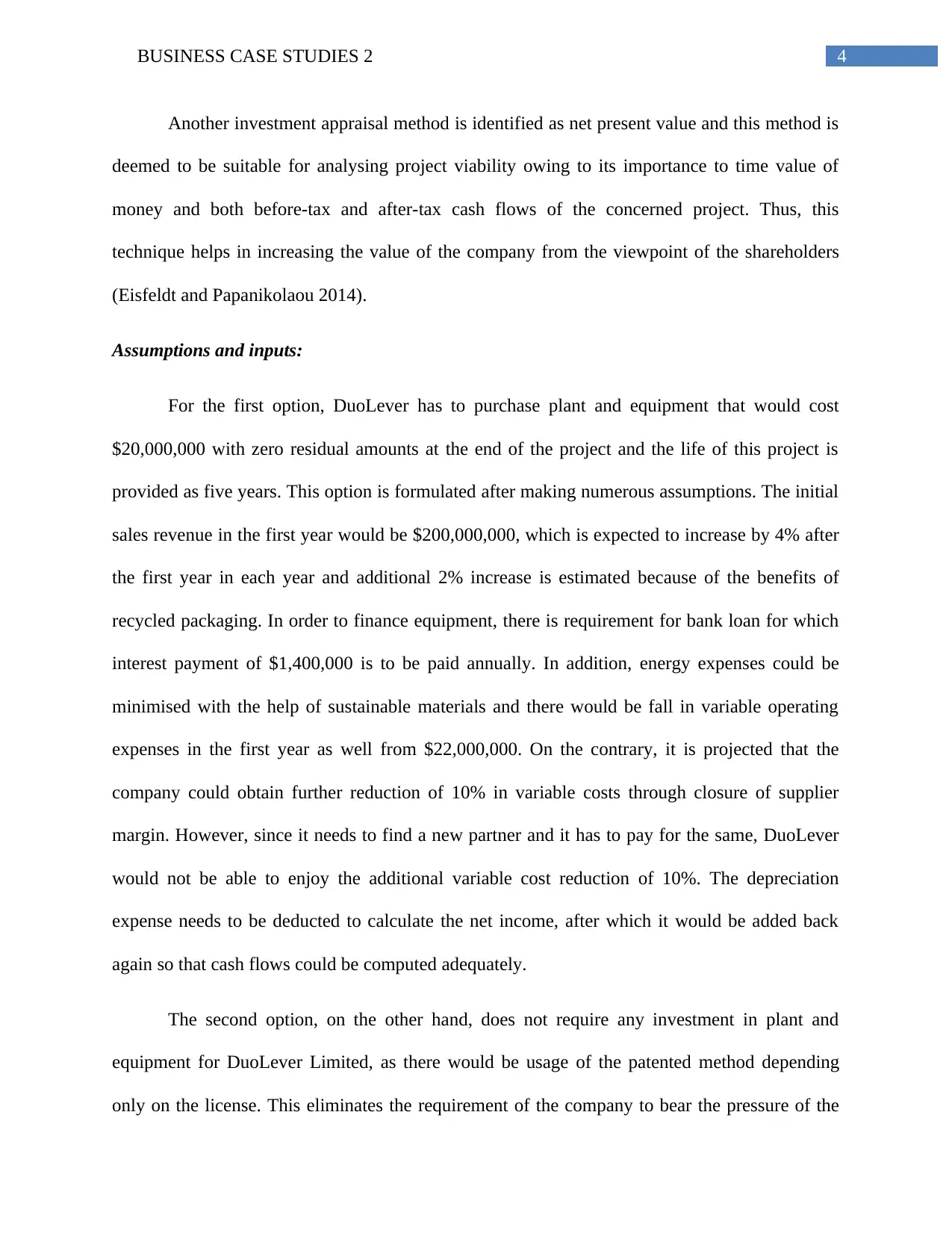
4BUSINESS CASE STUDIES 2
Another investment appraisal method is identified as net present value and this method is
deemed to be suitable for analysing project viability owing to its importance to time value of
money and both before-tax and after-tax cash flows of the concerned project. Thus, this
technique helps in increasing the value of the company from the viewpoint of the shareholders
(Eisfeldt and Papanikolaou 2014).
Assumptions and inputs:
For the first option, DuoLever has to purchase plant and equipment that would cost
$20,000,000 with zero residual amounts at the end of the project and the life of this project is
provided as five years. This option is formulated after making numerous assumptions. The initial
sales revenue in the first year would be $200,000,000, which is expected to increase by 4% after
the first year in each year and additional 2% increase is estimated because of the benefits of
recycled packaging. In order to finance equipment, there is requirement for bank loan for which
interest payment of $1,400,000 is to be paid annually. In addition, energy expenses could be
minimised with the help of sustainable materials and there would be fall in variable operating
expenses in the first year as well from $22,000,000. On the contrary, it is projected that the
company could obtain further reduction of 10% in variable costs through closure of supplier
margin. However, since it needs to find a new partner and it has to pay for the same, DuoLever
would not be able to enjoy the additional variable cost reduction of 10%. The depreciation
expense needs to be deducted to calculate the net income, after which it would be added back
again so that cash flows could be computed adequately.
The second option, on the other hand, does not require any investment in plant and
equipment for DuoLever Limited, as there would be usage of the patented method depending
only on the license. This eliminates the requirement of the company to bear the pressure of the
Another investment appraisal method is identified as net present value and this method is
deemed to be suitable for analysing project viability owing to its importance to time value of
money and both before-tax and after-tax cash flows of the concerned project. Thus, this
technique helps in increasing the value of the company from the viewpoint of the shareholders
(Eisfeldt and Papanikolaou 2014).
Assumptions and inputs:
For the first option, DuoLever has to purchase plant and equipment that would cost
$20,000,000 with zero residual amounts at the end of the project and the life of this project is
provided as five years. This option is formulated after making numerous assumptions. The initial
sales revenue in the first year would be $200,000,000, which is expected to increase by 4% after
the first year in each year and additional 2% increase is estimated because of the benefits of
recycled packaging. In order to finance equipment, there is requirement for bank loan for which
interest payment of $1,400,000 is to be paid annually. In addition, energy expenses could be
minimised with the help of sustainable materials and there would be fall in variable operating
expenses in the first year as well from $22,000,000. On the contrary, it is projected that the
company could obtain further reduction of 10% in variable costs through closure of supplier
margin. However, since it needs to find a new partner and it has to pay for the same, DuoLever
would not be able to enjoy the additional variable cost reduction of 10%. The depreciation
expense needs to be deducted to calculate the net income, after which it would be added back
again so that cash flows could be computed adequately.
The second option, on the other hand, does not require any investment in plant and
equipment for DuoLever Limited, as there would be usage of the patented method depending
only on the license. This eliminates the requirement of the company to bear the pressure of the
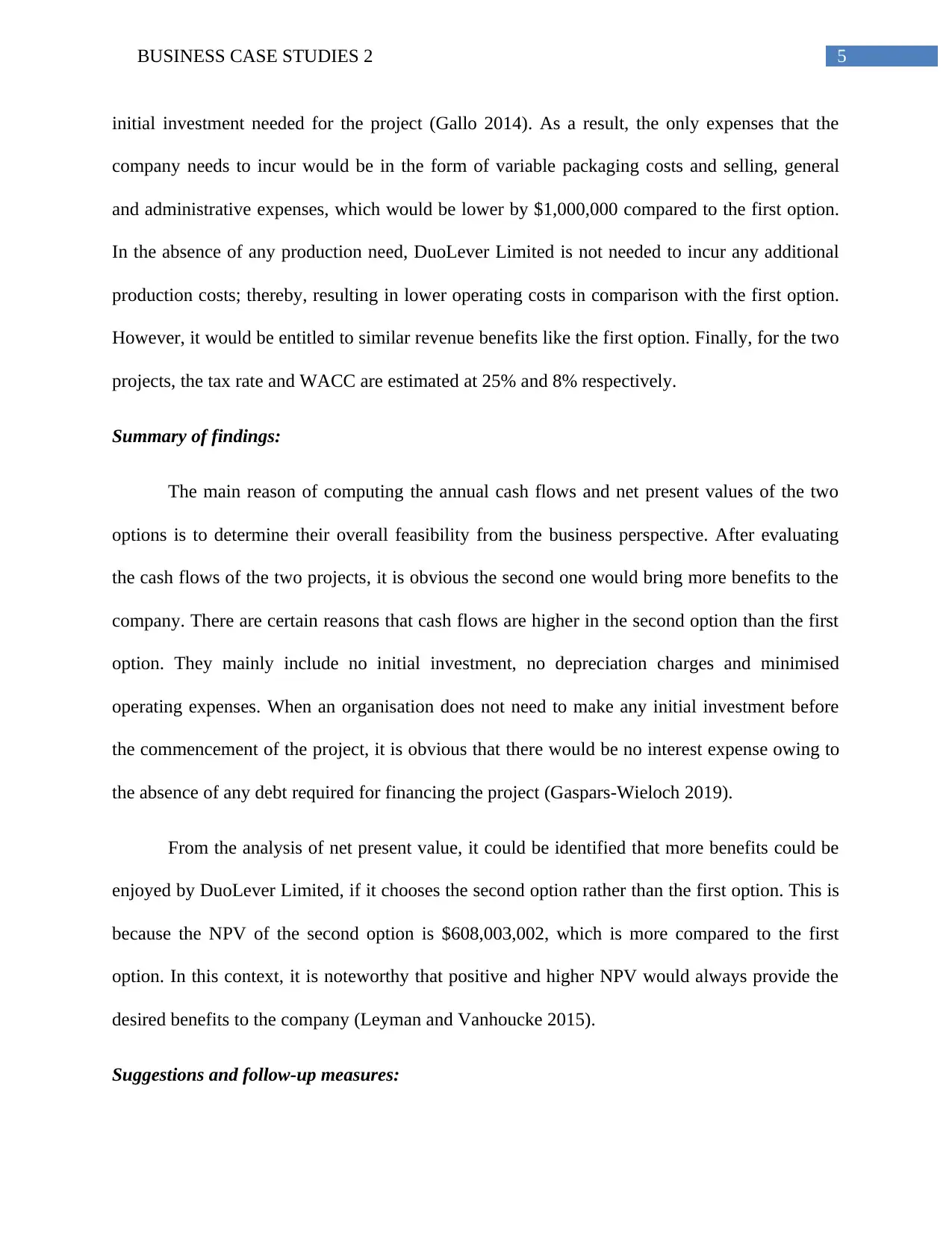
5BUSINESS CASE STUDIES 2
initial investment needed for the project (Gallo 2014). As a result, the only expenses that the
company needs to incur would be in the form of variable packaging costs and selling, general
and administrative expenses, which would be lower by $1,000,000 compared to the first option.
In the absence of any production need, DuoLever Limited is not needed to incur any additional
production costs; thereby, resulting in lower operating costs in comparison with the first option.
However, it would be entitled to similar revenue benefits like the first option. Finally, for the two
projects, the tax rate and WACC are estimated at 25% and 8% respectively.
Summary of findings:
The main reason of computing the annual cash flows and net present values of the two
options is to determine their overall feasibility from the business perspective. After evaluating
the cash flows of the two projects, it is obvious the second one would bring more benefits to the
company. There are certain reasons that cash flows are higher in the second option than the first
option. They mainly include no initial investment, no depreciation charges and minimised
operating expenses. When an organisation does not need to make any initial investment before
the commencement of the project, it is obvious that there would be no interest expense owing to
the absence of any debt required for financing the project (Gaspars-Wieloch 2019).
From the analysis of net present value, it could be identified that more benefits could be
enjoyed by DuoLever Limited, if it chooses the second option rather than the first option. This is
because the NPV of the second option is $608,003,002, which is more compared to the first
option. In this context, it is noteworthy that positive and higher NPV would always provide the
desired benefits to the company (Leyman and Vanhoucke 2015).
Suggestions and follow-up measures:
initial investment needed for the project (Gallo 2014). As a result, the only expenses that the
company needs to incur would be in the form of variable packaging costs and selling, general
and administrative expenses, which would be lower by $1,000,000 compared to the first option.
In the absence of any production need, DuoLever Limited is not needed to incur any additional
production costs; thereby, resulting in lower operating costs in comparison with the first option.
However, it would be entitled to similar revenue benefits like the first option. Finally, for the two
projects, the tax rate and WACC are estimated at 25% and 8% respectively.
Summary of findings:
The main reason of computing the annual cash flows and net present values of the two
options is to determine their overall feasibility from the business perspective. After evaluating
the cash flows of the two projects, it is obvious the second one would bring more benefits to the
company. There are certain reasons that cash flows are higher in the second option than the first
option. They mainly include no initial investment, no depreciation charges and minimised
operating expenses. When an organisation does not need to make any initial investment before
the commencement of the project, it is obvious that there would be no interest expense owing to
the absence of any debt required for financing the project (Gaspars-Wieloch 2019).
From the analysis of net present value, it could be identified that more benefits could be
enjoyed by DuoLever Limited, if it chooses the second option rather than the first option. This is
because the NPV of the second option is $608,003,002, which is more compared to the first
option. In this context, it is noteworthy that positive and higher NPV would always provide the
desired benefits to the company (Leyman and Vanhoucke 2015).
Suggestions and follow-up measures:
⊘ This is a preview!⊘
Do you want full access?
Subscribe today to unlock all pages.

Trusted by 1+ million students worldwide
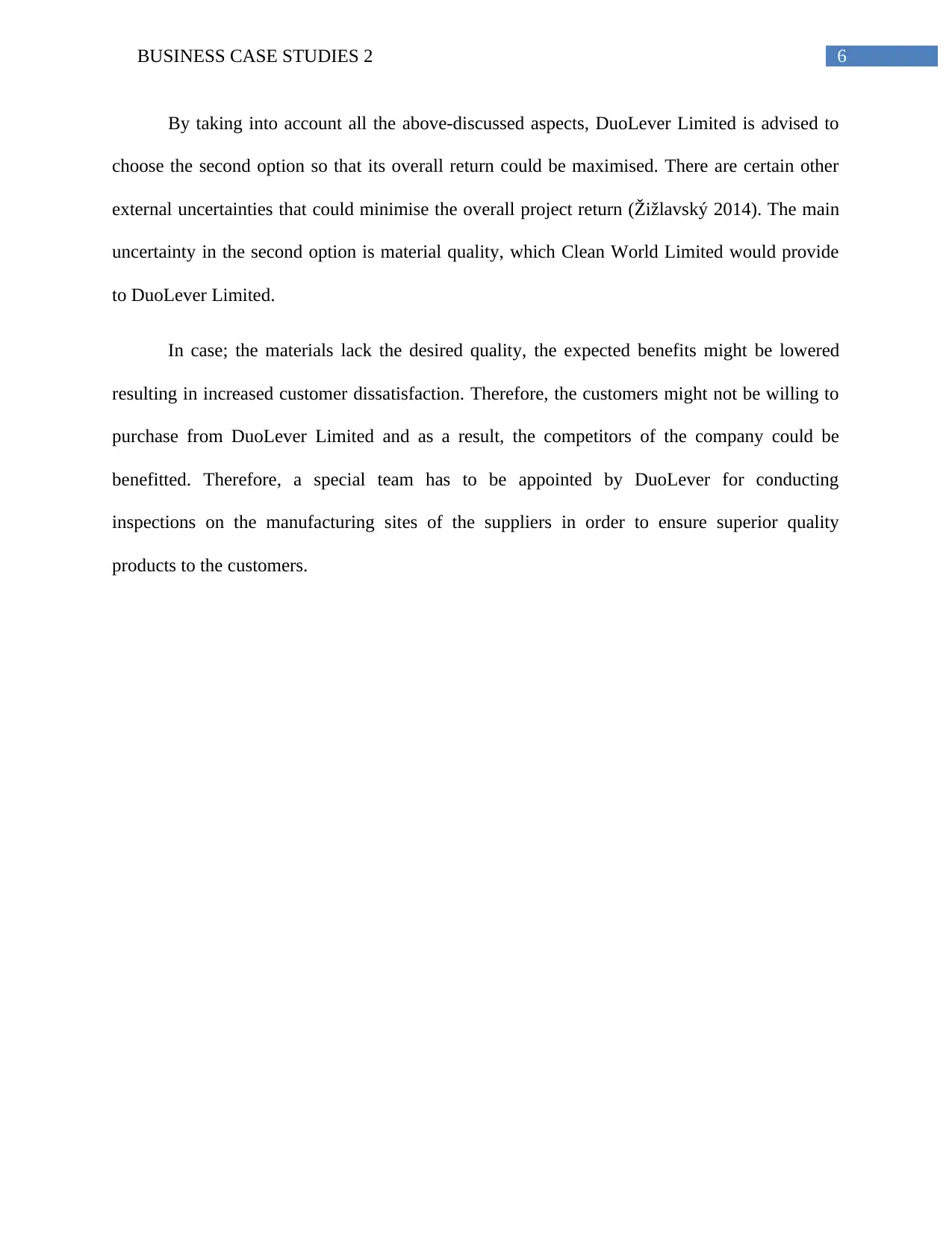
6BUSINESS CASE STUDIES 2
By taking into account all the above-discussed aspects, DuoLever Limited is advised to
choose the second option so that its overall return could be maximised. There are certain other
external uncertainties that could minimise the overall project return (Žižlavský 2014). The main
uncertainty in the second option is material quality, which Clean World Limited would provide
to DuoLever Limited.
In case; the materials lack the desired quality, the expected benefits might be lowered
resulting in increased customer dissatisfaction. Therefore, the customers might not be willing to
purchase from DuoLever Limited and as a result, the competitors of the company could be
benefitted. Therefore, a special team has to be appointed by DuoLever for conducting
inspections on the manufacturing sites of the suppliers in order to ensure superior quality
products to the customers.
By taking into account all the above-discussed aspects, DuoLever Limited is advised to
choose the second option so that its overall return could be maximised. There are certain other
external uncertainties that could minimise the overall project return (Žižlavský 2014). The main
uncertainty in the second option is material quality, which Clean World Limited would provide
to DuoLever Limited.
In case; the materials lack the desired quality, the expected benefits might be lowered
resulting in increased customer dissatisfaction. Therefore, the customers might not be willing to
purchase from DuoLever Limited and as a result, the competitors of the company could be
benefitted. Therefore, a special team has to be appointed by DuoLever for conducting
inspections on the manufacturing sites of the suppliers in order to ensure superior quality
products to the customers.
Paraphrase This Document
Need a fresh take? Get an instant paraphrase of this document with our AI Paraphraser
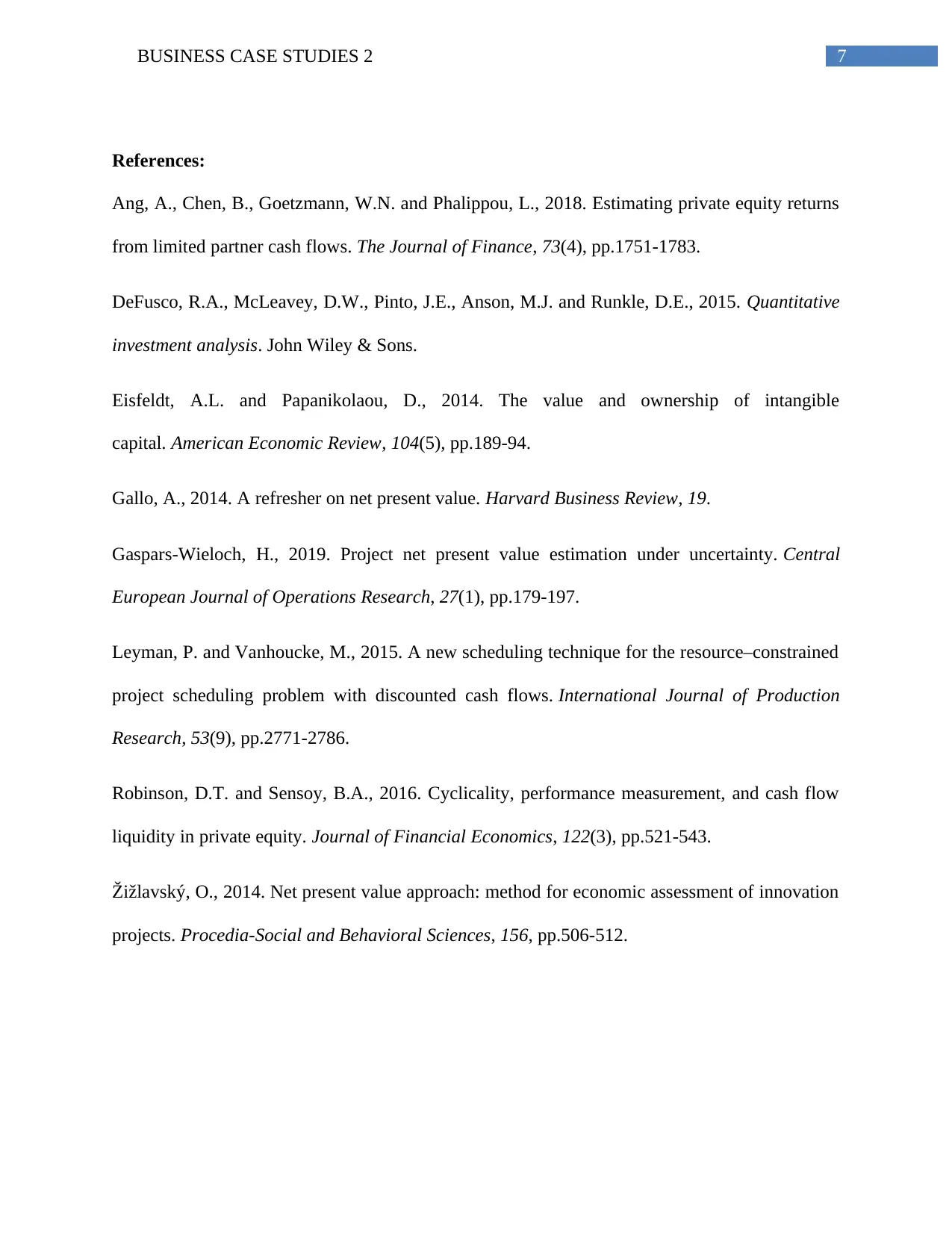
7BUSINESS CASE STUDIES 2
References:
Ang, A., Chen, B., Goetzmann, W.N. and Phalippou, L., 2018. Estimating private equity returns
from limited partner cash flows. The Journal of Finance, 73(4), pp.1751-1783.
DeFusco, R.A., McLeavey, D.W., Pinto, J.E., Anson, M.J. and Runkle, D.E., 2015. Quantitative
investment analysis. John Wiley & Sons.
Eisfeldt, A.L. and Papanikolaou, D., 2014. The value and ownership of intangible
capital. American Economic Review, 104(5), pp.189-94.
Gallo, A., 2014. A refresher on net present value. Harvard Business Review, 19.
Gaspars-Wieloch, H., 2019. Project net present value estimation under uncertainty. Central
European Journal of Operations Research, 27(1), pp.179-197.
Leyman, P. and Vanhoucke, M., 2015. A new scheduling technique for the resource–constrained
project scheduling problem with discounted cash flows. International Journal of Production
Research, 53(9), pp.2771-2786.
Robinson, D.T. and Sensoy, B.A., 2016. Cyclicality, performance measurement, and cash flow
liquidity in private equity. Journal of Financial Economics, 122(3), pp.521-543.
Žižlavský, O., 2014. Net present value approach: method for economic assessment of innovation
projects. Procedia-Social and Behavioral Sciences, 156, pp.506-512.
References:
Ang, A., Chen, B., Goetzmann, W.N. and Phalippou, L., 2018. Estimating private equity returns
from limited partner cash flows. The Journal of Finance, 73(4), pp.1751-1783.
DeFusco, R.A., McLeavey, D.W., Pinto, J.E., Anson, M.J. and Runkle, D.E., 2015. Quantitative
investment analysis. John Wiley & Sons.
Eisfeldt, A.L. and Papanikolaou, D., 2014. The value and ownership of intangible
capital. American Economic Review, 104(5), pp.189-94.
Gallo, A., 2014. A refresher on net present value. Harvard Business Review, 19.
Gaspars-Wieloch, H., 2019. Project net present value estimation under uncertainty. Central
European Journal of Operations Research, 27(1), pp.179-197.
Leyman, P. and Vanhoucke, M., 2015. A new scheduling technique for the resource–constrained
project scheduling problem with discounted cash flows. International Journal of Production
Research, 53(9), pp.2771-2786.
Robinson, D.T. and Sensoy, B.A., 2016. Cyclicality, performance measurement, and cash flow
liquidity in private equity. Journal of Financial Economics, 122(3), pp.521-543.
Žižlavský, O., 2014. Net present value approach: method for economic assessment of innovation
projects. Procedia-Social and Behavioral Sciences, 156, pp.506-512.
1 out of 8
Related Documents
Your All-in-One AI-Powered Toolkit for Academic Success.
+13062052269
info@desklib.com
Available 24*7 on WhatsApp / Email
![[object Object]](/_next/static/media/star-bottom.7253800d.svg)
Unlock your academic potential
Copyright © 2020–2025 A2Z Services. All Rights Reserved. Developed and managed by ZUCOL.





